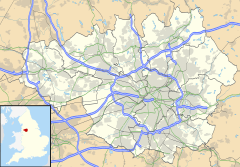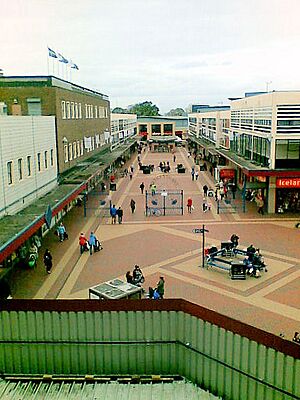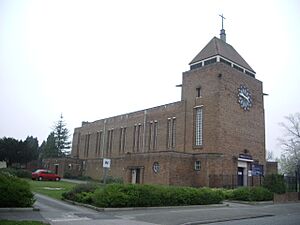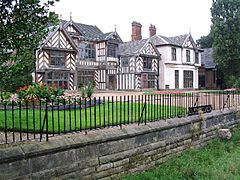Wythenshawe facts for kids
Quick facts for kids Wythenshawe |
|
|---|---|
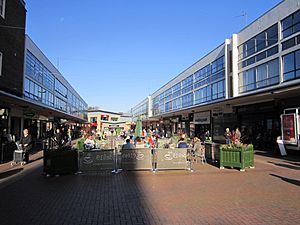 The centre |
|
| Population | 110,000 |
| OS grid reference | SJ824884 |
| Metropolitan borough | |
| Metropolitan county | |
| Region | |
| Country | England |
| Sovereign state | United Kingdom |
| Post town | MANCHESTER |
| Postcode district | M22 |
| Dialling code | 0161 |
| Police | Greater Manchester |
| Fire | Greater Manchester |
| Ambulance | North West |
| EU Parliament | North West England |
| UK Parliament |
|
Wythenshawe is a large area in south Manchester, England. It used to be part of Cheshire, but in 1931, it became part of the City of Manchester. This happened because Manchester started building a huge new housing estate there in the 1920s.
Wythenshawe covers about 11 square miles (28 square kilometres). It grew to become one of the biggest council estates in Europe. Even though it's not officially a town, the main area has a Manchester Metrolink tram stop called Wythenshawe Town Centre tram stop.
Wythenshawe includes several smaller areas. These are Baguley, Benchill, Peel Hall, Newall Green, Woodhouse Park, Moss Nook, Northern Moor, Northenden and Sharston.
Contents
History of Wythenshawe
The name Wythenshawe comes from old English words. Wiðign means "willow tree" and sceaga means "wood". So, it likely means "willow wood".
For a long time, the name Wythenshawe only referred to Wythenshawe Hall and its land. In 1931, three old areas – Northenden, Baguley, and Northen Etchells – officially joined together. This created the Wythenshawe we know today.
Wythenshawe Hall and its Story
Wythenshawe Hall is an old, grand house and a famous landmark in Wythenshawe Park. Due to money cuts, the hall was closed to visitors for a while in 2010. A group of local people formed a "Friends Group" to help keep it open. They organised monthly open days and events.
Sadly, in March 2016, a fire badly damaged the hall's roof, an upper floor, and its clock tower. This fire was started on purpose.
Early Airport History
Just south of Wythenshawe is Manchester Airport. It used to be called Ringway Airport. Before this big airport was built, a smaller airfield existed in Wythenshawe. It was called Manchester (Wythenshawe) Aerodrome.
This was the UK's first local airfield, open from April 1929 to early 1930. A barn was used as a hangar for planes, and a farmhouse became the office building. The last flight from this early airport was in June 1930.

Housing and Community Life
Wythenshawe is Manchester's largest area. In the 1920s, a huge housing estate was built here. The idea was to create a "garden city" where people could move away from the busy industrial parts of Manchester.
In 1920, a city planner named Patrick Abercrombie found this area perfect for new homes. About 2,500 acres (1,000 hectares) of land were bought for the project.
Building the Estate
Some parts of Wythenshawe were built before World War II. These included parts of Benchill and some northern areas. The rest of the estate was built after the war, starting in the late 1940s. Back then, parts of Baguley were still like the countryside. Today, there's very little open land left.
Shops and Services Grow
When the estate was first built, it didn't have many shops or services. There were also very few jobs nearby. Northenden already had some shops. The first new shops in Wythenshawe were built in the 1930s. These included shops on Hollyhedge Road and Altrincham Road.
It took many years for some areas of Wythenshawe to get their own local shops. This meant people had to travel or wait for a mobile shop van. Local groups were formed to try and fix these problems, but it was a slow process.
After World War II, Wythenshawe grew a lot. More shops were built, and businesses came to the area. This happened with the growth of the Sharston Industrial Estate and later, the Moss Nook and Roundthorn industrial areas.
Wythenshawe slowly gained all the things the first planners had missed. Many new schools, shops, pubs, and churches were built. The area also got its own hospital, Wythenshawe Hospital, which started in 1948.
The biggest shopping area was built in the 1960s. It's known as the Wythenshawe Civic Centre. It has grown even more since it was first built. In 1971, the Wythenshawe Forum opened there. It had a library, a swimming pool, a restaurant, a bar, and a theatre.
Changes in Housing Ownership
From the 1990s to the 2000s, the council-owned houses were given to local housing associations. These included Willow Park and Parkway Green. In 2013, these two groups joined to form the Wythenshawe Community Housing Group. This group now manages about 14,000 homes in Wythenshawe.
Old Farms and New Uses
Most of the old farm buildings in Wythenshawe were taken down when the estate was built. Some, like Hollyhedge Farm, were left but were later damaged and had to be removed. Some of the housing areas today are named after these old farms.
Peel Hall Farm, which had a moat (a ditch around it), lasted for over 20 years. But after its owner left, it was damaged and had to be demolished.
Newall Green Farm survived on the edge of the Newall Green housing area. It was still a working farm until the early 2000s. The buildings are now protected. In 2014, vandals set fire to the farm, destroying its roof. However, there are plans to turn the buildings into a care home for adults with learning disabilities. It will also be a working farm and a horse-riding centre.
Parks and Green Spaces
Wythenshawe has many green areas. There are twelve parks and 18 woodland areas.
Wythenshawe Park
Wythenshawe Park is a very important green space. It was named a Local Nature Reserve in 2011. The park covers over 270 acres (109 hectares). It is home to Manchester's only community farm, Wythenshawe community farm.
At the heart of the park is the historic Wythenshawe Hall. The park also has riding stables, a gardening centre, a children's play area, and sports facilities. These include an athletics track, football pitches, tennis courts, and bowling greens.
Other Parks
Other parks in Wythenshawe include Hollyhedge Park, Peel Hall Park, Painswick Park, and Baguley Park. Northenden's Riverside Park is the first new park created in the city in the 21st century.
Local Government
Wythenshawe is managed by Manchester City Council.
Parliamentary Representation
The Wythenshawe and Sale East area has its own Member of Parliament (MP). This MP represents the area in the UK Parliament. The area has usually voted for the Labour Party.
In 2014, after the death of the previous MP, Paul Goggins, a special election was held. Mike Kane from the Labour Party won this election. In the 2017 general election, Labour received a very high number of votes in the area.
Local Council Wards
In 2001, Wythenshawe was divided into six local government areas called wards. These were Baguley, Benchill, Northenden, Sharston, Woodhouse Park, and Brooklands. Each ward had three local councillors. This meant Wythenshawe had 21 of the 99 seats on Manchester City Council.
Later, in 2003, the Benchill ward was removed. Its areas were divided among Northenden, Sharston, and Woodhouse Park wards.
Wythenshawe usually elects Labour councillors in local elections. However, in recent years, the Green Party has also gained some councillors in the Woodhouse Park ward.
Geography of Wythenshawe
Wythenshawe is about 8 miles (13 kilometres) south of Manchester city centre. It is the southernmost part of Manchester. Nearby towns include Altrincham and Hale to the south-west, and Sale to the north-west. The Metropolitan Borough of Stockport is to the east, with suburbs like Gatley and Heald Green bordering Wythenshawe. Manchester Airport is right to the south.
Shadow Moss Area
Shadow Moss is an area in the south-east corner of Wythenshawe. It used to be a peat bog, where people dug for peat fuel. This fuel was called "turf". In the 19th century, this area became used for growing vegetables and plants, with many greenhouses.
The small settlement of Heyhead was in this area. It had houses, a shop, and a chapel. However, as Manchester Airport expanded, the Heyhead area was gradually replaced by car parks. By 2011, all of Heyhead's buildings were gone.
Some greenhouses still exist in the far east of Shadow Moss today. They are used by private car parking companies, not for growing crops. The last market gardener there, who grew tomatoes, closed his business in 2011.
 |
Sale Moor | Northenden | Gatley |  |
| Timperley | Gatley/Heald Green | |||
| Hale | Manchester Airport | Heald Green |
Public Services
Wythenshawe is kept safe by the city of Manchester Division of Greater Manchester Police. Fire and rescue services are provided by the Greater Manchester Fire and Rescue Service. Their fire station is on Brownley Road.
Transport Links
The M56 motorway was built in the 1970s. It cuts through east and west Wythenshawe. A bypass connecting it to the nearby M60 motorway was opened in 1974.
Railway and Tram Services
Wythenshawe did not have its own public train service for many years. The closest train stations were in nearby Gatley, Heald Green, and Altrincham. A train station at Manchester Airport opened in 1993.
The Airport Line of the Manchester Metrolink tram service now has twelve stops in Wythenshawe. This tram line opened in November 2014. A new public transport hub was also built in Wythenshawe Town Centre. It opened in June 2015 and includes a new bus station and tram stop.
Economy and Businesses
About 43,000 people work in Wythenshawe. There are four main industrial areas: Moss Nook, Ringway (Airport Cargo Centre), Roundthorn, and Sharston.
Wythenshawe is home to Manchester Airport and Wythenshawe Hospital. These are two of the biggest employers in the area. Many national and international companies also have offices or buildings here. These include Timpson Ltd, HellermannTyton, Virgin Media, Vodafone, and F. Duerr & Sons.
In 1934, George Hamer Scholes built the Wylex Works to make electrical parts. This company is now part of Siemens.
New housing developments are also being built in the area.
Wythenshawe Civic Centre
The town centre, called the Civic Centre, was first built in the 1960s. It has grown over the years. Between 1999 and 2002, it was updated with new stores and features. The main shopping area now has gates that are locked at night to prevent damage.
The Forum centre, which opened in 1971, has a library, a leisure centre, a swimming pool, and a cafe. It has also been updated. It used to have the Forum Theatre, but this closed in 2002. Now, a health clinic and an adult education centre are in that space.
In 2007, Asda opened a new large supermarket where an old Co-operative store used to be. A walkway near the supermarket has a wall mosaic showing different parts of the town. After two tall blocks of flats were taken down in 2007, new buildings were put up. These include a new Wilko shop and offices.
In 2022, Manchester City Council announced that it bought Wythenshawe town centre. This is part of bigger plans to improve the town centre.
Wythenshawe in the Media
Wythenshawe has been used as a filming location for TV shows. The Channel 4 series Shameless filmed outdoor scenes here. It showed the local tower blocks, housing estates, and buildings unique to the area. The show's outdoor sets were also built on private land in Wythenshawe.
In 2009, Sarah Ferguson, Duchess of York made a TV show for ITV1 called The Duchess on the Estate. In the show, she visited the Northern Moor area of Wythenshawe. She met local people to talk about their lives and opened a new community centre.
Famous People from Wythenshawe
Many well-known people have connections to Wythenshawe:
- Johnny Marr, musician and guitarist for the Smiths, moved to Wythenshawe in 1972.
- Lorraine Cheshire, an actress, was born here.
- Tyson Fury, a professional boxer and heavyweight world champion, was born and grew up in Wythenshawe.
- Harry H. Corbett, an actor, went to primary and secondary schools in Wythenshawe.
- Anthony Taylor, a professional football referee, was born in Wythenshawe.
- Marcus Rashford MBE, a famous footballer for Manchester United and England, was born in Wythenshawe.
- Jimmy Kelly, a professional boxer, lived here.
- Rob Gretton, manager of the band Joy Division, was born in Wythenshawe.
- Jason Orange, a singer from Take That, lived in Wythenshawe as a child.
- Caroline Aherne, a comedian and actress, grew up in Wythenshawe.
- Actors from Coronation Street like Simon Gregson, Nicholas Cochrane, Chris Bisson, and Kevin Kennedy were born in Wythenshawe.
- Alf Wood, a footballer for several clubs, lived in Newall Green.
- Duncan Hallas, a political leader, grew up here.
- Ravel Morrison, a former Manchester United footballer, was born in Wythenshawe.
- Jimmy Egan, a boxing trainer who trained famous boxers, worked at Wythenshawe East Amateur Boxing Club.
- Paul Stewart, a footballer who played for England, lived in Northern Moor.
- John Bradley-West, an actor from Game of Thrones, grew up and went to school in Wythenshawe.
- Michael Wood, a historian, moved to Wythenshawe at age eight.
- Syd Little, a comedian from Little and Large, went to school in Wythenshawe.
- Paul Young, lead singer of Mike and the Mechanics, was born in Benchill.
- Steve McGarry, a cartoonist and illustrator, was born and raised in Benchill.
- Joe Gallagher, a professional boxing trainer, grew up in Benchill.
- Shay Logan, a professional footballer, is known for his time at Aberdeen.
- Shay Brennan, a Manchester United footballer, grew up in Wythenshawe.
- Cole Palmer, a current Chelsea professional footballer, was born in Wythenshawe.
- Lukas Nmecha and Felix Nmecha, brothers who are professional footballers, both grew up in Wythenshawe.
- Slaughter & the Dogs are a punk rock band formed in Wythenshawe in 1975.
- Kirsty Howard was known for her fundraising for a children's hospice. She was born in Wythenshawe.
- Freddie Garrity, frontman of Freddie and the Dreamers, was also from Wythenshawe.
|


